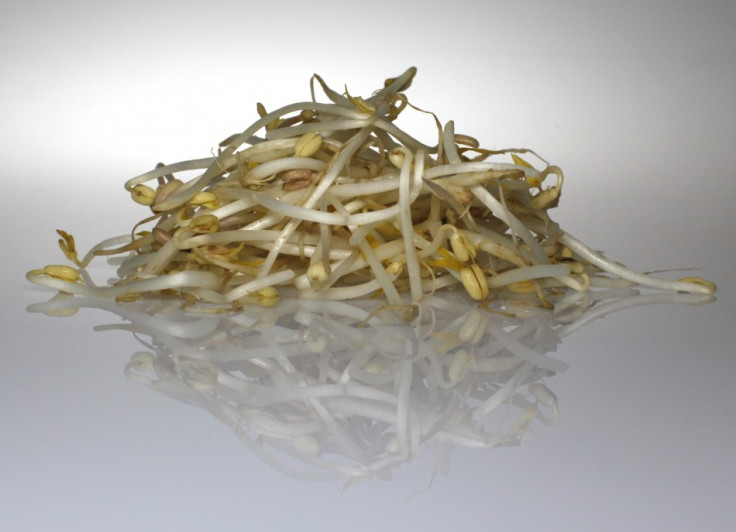E.coli 2011 symptoms: Outbreak traced to German bean sprouts

The E.coli strain responsible for Europe's deadly outbreak has been identified as an evolved and particularly toxic version of the bacteria first identified in Münster, Germany, in 2001, according to two separate teams of scientists.
Locally-grown bean sprouts have been acknowledged as the cause of the outbreak that has killed 29 and sickened nearly 3,000.
The head of Germany's national disease control centre, Reinhard Burger, said that even though no tests of the sprouts from a farm in Lower Saxony had come back positive, the epidemiological investigation of the pattern of the outbreak had produced enough evidence to draw the conclusion.
"It is the sprouts," Mr Burger said. He added that the institute is lifting its warning against eating cucumbers, tomatoes and lettuce but keeping the warning in place for the sprouts.
The Department of Health has confirmed that no further cases have been reported in the U.K. since Friday 3 June.
Unlocking the mystery
Scientists said the swift genetic analysis will help answer the mystery of the outbreak. "Everything we know so far indicates it is an evolved strain," said Alexander Mellmann of the University Hospital of Münster, who was involved in one of the genetic analyses.
"If it was completely unknown, we'd struggle a lot more in our effort to fight it."
In addition to Dr. Mellmann's group, a separate team from BGI, formerly known as the Beijing Genomics Institute, and University Medical Center Hamburg-Eppendorf compared the genetic material of the 2001 and 2011 strains. They found that seven genes crucial to both strains' survival are identical, as are 12 virulence/fitness genes shared by both.
The 2011 version is resistant to eight classes of antibiotics, including penicillin, streptomycin and sulfonamide. The overexposure of the strain to antibiotics within the food chain has been posited as a reason for the rapid evolution of the bacteria. Immunity against many more antibiotics "resulted in the gain of more genes during the last 10 years", said BGI.
Q & A
Here are the answers to some common questions surrounding the outbreak:
1. What is E.coli? Escherichia coli (E.coli) are a group of bacteria that live in the intestines of many animals, including humans. There are many strains of E.coli and most are harmless, but others can cause illness ranging from diarrhoea to pneumonia. Subsequently, infections can be mild to life-threatening.
2. How is E.coli spread? E.coli infections are caused by ingesting the feces of infected animals or humans, often via contaminated food or water. People can contaminate food by failing to wash their hands after using the toilet or changing a baby's diaper but it can spread from person to person if the strain is infectious enough. This is what health officals are fearful of with the latest outbreak.
3. What is the current strain?One particular E.coli strain, E.coli 0157:H7 is notorious for its potential to cause disease in humans. The strain that has been identified in Germany and other parts of Europe is known as 0104:H4. This strain of E.coli causes an illness similar to infection with O157:H7.
It is part of a class of bacteria known as Shiga toxin-producing Escherichia coli, or STEC. It is the first time the strain has caused an outbreak in humans.
Symptoms of STEC infections vary for each person but often include severe stomach cramps, diarrhea (often bloody) and vomiting. Low fever (less than 38.5 degrees C) also may be present. Most people recover within five to seven days.
4. What are the symptoms of this strain? Hundreds of people affected by this outbreak have developed hemolytic uremic syndrome, or HUS, a life-threatening complication of E.coli infections. The syndrome, which results in the destruction of red blood cells and severe kidney problems, usually arises about a week after diarrhoea starts.
Symptoms of HUS include decreased frequency of urination, extreme fatigue and the loss of the skin's pink color in the cheeks and inside the lower eyelids. Children, the elderly and people with compromised immune systems usually are at highest risk for HUS. In the case of this outbreak, healthy adult women have been hardest hit.
5. What is the medical treatment? Experts said supportive therapy, including hydration, is important. Treatment for HUS includes dialysis for kidney failure and blood transfusions for anaemia. Antibiotics should not be used, as there is no evidence that treatment with antibiotics is helpful. Antibiotics and antidiarrheal agents like Imodium also may increase risk of HUS.
© Copyright IBTimes 2025. All rights reserved.




















